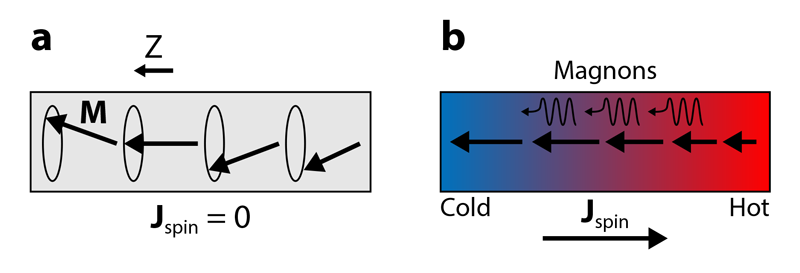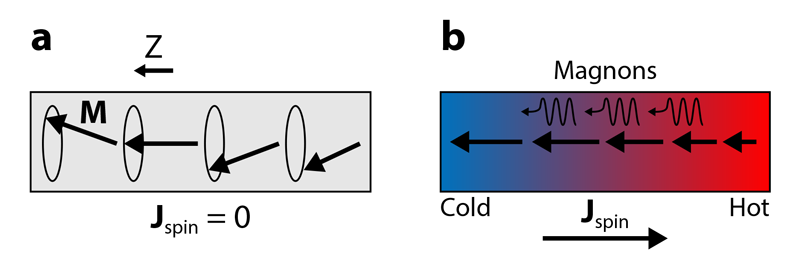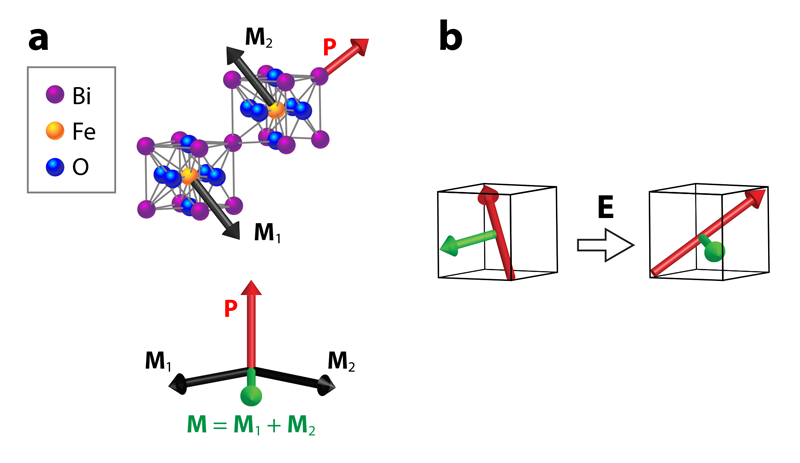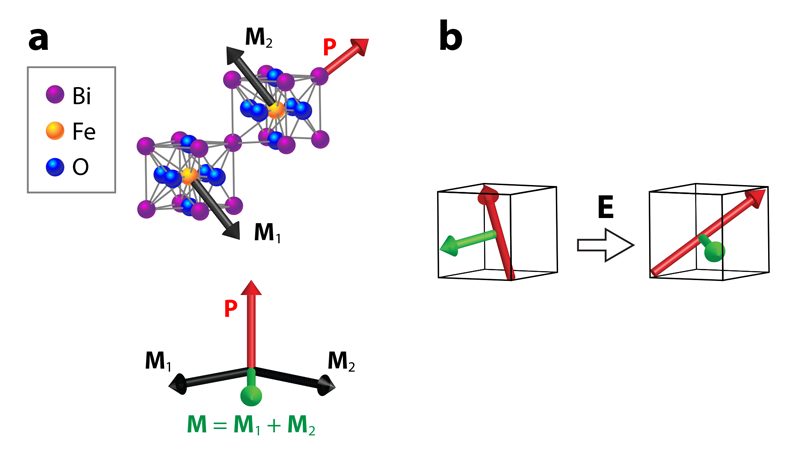Multiferroics Are a Spintronics Game Changer
As you read this article, billions of transistors are switching electrical currents on and off inside your computer, generating heat in the process. This “heating problem” is the inevitable result of energy dissipation associated with electrons moving around, and it threatens to hinder further development of silicon-based computer technology. A possible solution to the problem is to make novel electronic devices that take advantage of each electron’s intrinsic magnetic moment (spin). In an insulator (as opposed to a metal or a semiconductor), it is possible to transport these spins without moving the electrons themselves, and in a device that uses spin currents instead of charge currents, energy dissipation would be greatly reduced, providing the much-desired pathway to increase computing power while avoiding the heating problem [1]. But whereas charge currents can be induced easily using electric fields, an equivalent method of control does not exist for spin currents. Now Eric Parsonnet at the University of California, Berkeley, and his colleagues have taken an important step toward a spin-based computer by demonstrating a way to switch spin currents on and off electrically [2].
The development of devices based on pure spin currents instead of charge currents is the goal of a large community of scientists and engineers working in spin electronics, or spintronics. A subfield of spintronics, called magnonics, focuses on devices in which these spin currents are carried specifically by magnons—wave-like disturbances of the aligned spins in a magnetic material [3, 4]. Magnonics researchers face a challenge in that simply exciting magnons in a material is not enough to guarantee the creation of a spin current: when the magnons are uniformly distributed, the spin current is exactly equal to zero [Fig. 1(a)]. The magnons must be controlled, and controlling magnons in insulating materials—ones that, because of the absence of charge currents, dissipate the least amount of energy—has proven difficult. In previous experiments, researchers have sought to achieve this control using large magnetic fields, but such fields can cause collateral heating, undermining the reason for pursuing magnonics in the first place [5, 6].
This is where the rare class of magnetoelectric multiferroic materials may provide a path forward. In multiferroic materials, multiple ferroic phases coexist at the same temperature. The most notable member of this class is bismuth ferrite ( BiFeO3), a rare example of a multiferroic that is both magnetic and ferroelectric at room temperature. This coexistence of phases means that the material has a remnant magnetization M and electric polarization P even when it is not subject to external fields [7]. Previous work demonstrated all-electrical switching of magnons in BiFeO3 [8, 9], but using this switching to gain control of spin currents was only a theorist’s dream [10].
The experiment by Parsonnet and his colleagues changes the game. Their result rests on the shoulders of the giants of spintronics who showed how to establish pure spin currents via the Seebeck effect and how to detect them via the inverse spin Hall effect [11]. In their experiment, the Seebeck effect generates a pure spin current when one side of the BiFeO3 film is heated [Fig. 1(b)]: thermal magnons flow along the temperature gradient from warm to cold, while the spin current flows in the opposite direction. The inverse spin Hall effect reveals the presence and direction of this spin current by turning it into a detectable voltage.
But Parsonnet and his colleagues go beyond this simple creation and detection of spin currents by switching the direction of the BiFeO3 film’s ferroelectric moment P using an electric field pulse (Fig. 2). This change in P forces the associated magnetization M to relax into another equilibrium direction perpendicular to P [12]. The researchers show that this linked switching of both P and M connects two states with different spin-current directions, demonstrating an all-electrical way of controlling spin currents in an insulator. Crucially for spintronic applications, these states are nonvolatile in that they remain stable when no electric or magnetic fields are applied; that is, their standby power is zero.
By using BiFeO3 thin films to demonstrate that nonvolatile, all-electrical switching of pure spin currents is possible without magnetic fields, Parsonnet and his colleagues have made multiferroic materials a strong contender in the spintronics game. Future work should see this switch converted into the spin-current equivalent of a transistor, and with companies such as Intel seriously considering spintronic alternatives to conventional silicon technology [1], we are poised for many more breakthroughs in the future.
References
- S. Manipatruni et al., “Scalable energy-efficient magnetoelectric spin–orbit logic,” Nature 565, 35 (2018).
- E. Parsonnet et al., “Nonvolatile electric field control of thermal magnons in the absence of an applied magnetic field,” Phys. Rev. Lett. 129, 087601 (2022).
- A. V. Chumak et al., “Magnon spintronics,” Nat. Phys. 11, 453 (2015).
- A. Barman et al., “The 2021 magnonics roadmap,” J. Phys.: Condens. Matter 33, 413001 (2021).
- R. Lebrun et al., “Tunable long-distance spin transport in a crystalline antiferromagnetic iron oxide,” Nature 561, 222 (2018).
- C. Liu et al., “Electric field control of magnon spin currents in an antiferromagnetic insulator,” Sci. Adv. 7, eabg1669 (2021).
- N. A. Spaldin et al., “Multiferroics: Past, present, and future,” Phys. Today 63, 38 (2010).
- R. de Sousa and J. E. Moore, “Electrical control of magnon propagation in multiferroic BiFeO3 films,” Appl. Phys. Lett. 92, 022514 (2008).
- P. Rovillain et al., “Electric-field control of spin waves at room temperature in multiferroic BiFeO3,” Nat. Mater 9, 975 (2010).
- W. Chen and M. Sigrist, “Dissipationless multiferroic magnonics,” Phys. Rev. Lett. 114, 157203 (2015).
- K. Uchida et al., “Thermal spin pumping and magnon-phonon-mediated spin-Seebeck effect,” J. Appl. Phys. 111, 103903 (2012).
- R. de Sousa, “The “Holy Grail” of Multiferroic Physics,” Phys. Canada 72, No. 2, 57 (2016), https://pic-pac.cap.ca/index.php/Issues/showpdf/article/v72n2.0-a2541.pdf.







